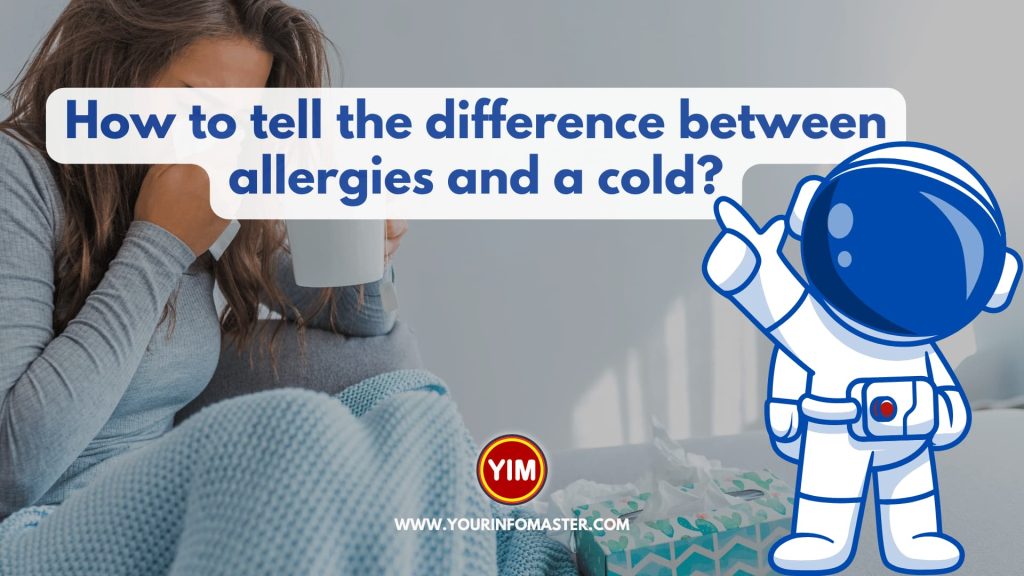I am going to explain the blog post “How to tell the difference between allergies and a cold?“
I have noticed that people often mistake allergies for a cold and vice versa. Both can cause similar symptoms, making it difficult to determine what you’re dealing with. It’s important to know the differences between allergies and a cold to get the right treatment and relief.
Check also: What is the difference between a fruit and a vegetable?
Check also: Water Intake Calculator
10 Differences between allergies and a cold
So, how can you tell the difference between allergies and a cold? While some symptoms may overlap, there are distinct differences in how they present and their causes. Allergies are caused by an immune system reaction to allergens, while a cold is caused by a viral infection.
Check also: What’s the difference between a bison and a buffalo?
Here is a list of 10 differences between allergies and a cold:
- Onset of Symptoms
- Duration of Symptoms
- Type of Symptoms
- Fever
- Body Aches and Pains
- Nasal Discharge
- Eye Symptoms
- Throat Symptoms
- Time of Year
- Triggers
Check also: What is the difference between term and whole life insurance?
- Onset of Symptoms: Allergy symptoms usually start immediately after exposure to an allergen, while cold symptoms usually take a few days to develop after being exposed to a virus.
- Duration of Symptoms: Allergy symptoms can last for weeks or months if you continue to be exposed to the allergen. In contrast, cold symptoms usually only last for a week to 10 days.
- Type of Symptoms: Allergies commonly cause symptoms such as itching, sneezing, and watery eyes. Colds, on the other hand, typically cause symptoms such as a sore throat, cough, and congestion.
- Fever: A fever is a symptom of a cold, but not of allergies. If you have a fever, it’s likely that you have a cold and not allergies.
- Body Aches and Pains: Body aches and pains are common with a cold, but not with allergies. If you’re experiencing body aches and pains, it’s likely that you have a cold.
- Nasal Discharge: With allergies, nasal discharge is usually clear and thin. With a cold, nasal discharge can be thicker and may change color over time.
- Eye Symptoms: Allergies can cause red, itchy, and watery eyes, which are not typically a symptom of a cold.
- Throat Symptoms: Sore throat is a common symptom of a cold, but not of allergies. If you have a sore throat, it’s likely that you have a cold and not allergies.
- Time of Year: Allergies tend to occur during specific times of the year when certain allergens are present, such as pollen during the spring and summer. Colds can occur year-round but are more common during the winter months.
- Triggers: Allergies are triggered by exposure to specific allergens, such as pollen, pet dander, or dust mites. Colds are caused by a viral infection, and you can catch a cold from being in contact with someone who is infected with the virus.
Conclusion
In conclusion, it’s important to know the differences between allergies and a cold to get the right treatment and relief. While both can cause similar symptoms, such as congestion and sneezing, there are distinct differences in how they present and their causes. By understanding the differences, you can determine what you’re dealing with and take the appropriate steps to feel better.
See also: What is the difference between a lawyer and an attorney?
If you really enjoyed the article “How to tell the difference between allergies and a cold?,” then I would be very grateful if you’d help it spread by emailing it to your friends or sharing it on Twitter, Instagram, or Facebook. Thank you!
Have you read “How to tell the difference between allergies and a cold?“ Which of these blogs are you reading, and how is it similar to one of them?

